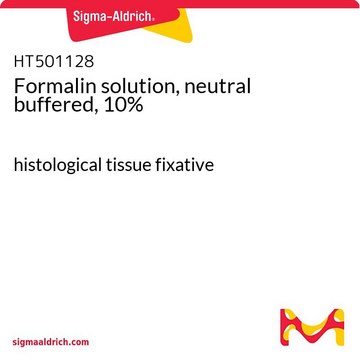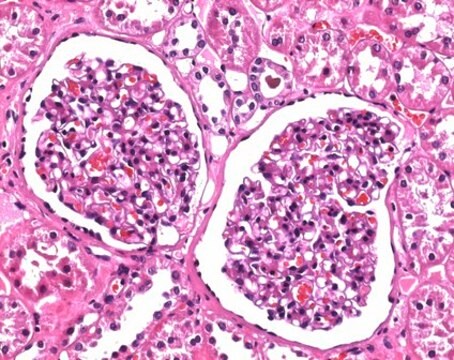Kluczowe dokumenty
F8775
Formaldehyde solution
for molecular biology, 36.5-38% in H2O
Synonim(y):
Formalin
About This Item
Polecane produkty
klasa czystości
Molecular Biology
for molecular biology
gęstość pary
1.03 (vs air)
ciśnienie pary
52 mmHg ( 37 °C)
Formularz
liquid
temp. samozapłonu
572 °F
zawiera
10-15% methanol
stężenie
36.5-38% in H2O
metody
ChIP: suitable
immunofluorescence: suitable
immunohistochemistry: suitable
gęstość
1.09 g/mL at 25 °C (lit.)
przydatność
suitable for (use in Formaldehyde-Agarose Gel Electrophoresis of RNA)
Zastosowanie
general analytical
genomic analysis
temp. przechowywania
15-25°C
ciąg SMILES
[H]C([H])=O
InChI
1S/CH2O/c1-2/h1H2
Klucz InChI
WSFSSNUMVMOOMR-UHFFFAOYSA-N
Szukasz podobnych produktów? Odwiedź Przewodnik dotyczący porównywania produktów
Opis ogólny
- Preservative: Formaldehyde′s ability to inhibit microbial growth makes it an effective preservative in biological samples, preventing decay and ensuring their integrity for further analysis. This property finds application in medical laboratories, museums, and even embalming fluids.
- Fixative: In histology, formaldehyde acts as a fixative, cross-linking proteins and preserving tissue structures for microscopic examination. This allows researchers to visualize anatomical details and cellular components with remarkable clarity.
- Denaturant: In molecular biology techniques like formaldehyde-agarose gel electrophoresis, formaldehyde denatures RNA molecules, preventing them from forming secondary structures and enabling size-based separation. This technique proves invaluable for studying gene expression and RNA integrity.
Zastosowanie
Cechy i korzyści
- Versatile and adaptable for a wide variety of laboratory and research applications
- Suitable for Molecular Biology and Biochemical applications
Komentarz do analizy
Inne uwagi
produkt podobny
Hasło ostrzegawcze
Danger
Zwroty wskazujące rodzaj zagrożenia
Zwroty wskazujące środki ostrożności
Klasyfikacja zagrożeń
Acute Tox. 2 Inhalation - Acute Tox. 3 Dermal - Acute Tox. 3 Oral - Carc. 1B - Eye Dam. 1 - Flam. Liq. 3 - Muta. 2 - Skin Corr. 1B - Skin Sens. 1 - STOT SE 1 - STOT SE 3
Organy docelowe
Eyes,Central nervous system, Respiratory system
Kod klasy składowania
3 - Flammable liquids
Klasa zagrożenia wodnego (WGK)
WGK 3
Temperatura zapłonu (°F)
133.0 °F - closed cup
Temperatura zapłonu (°C)
56.11 °C - closed cup
Wykazy regulacyjne
Wykazy regulacyjne dotyczą głównie produktów chemicznych. Można w nich podawać ograniczoną liczbę informacji na temat produktów niechemicznych. Brak wpisu oznacza, że żaden ze składników nie znajduje się w wykazie. Użytkownik odpowiada za zagwarantowanie bezpiecznego i zgodnego z prawem stosowania produktu.
Wybierz jedną z najnowszych wersji:
Masz już ten produkt?
Dokumenty związane z niedawno zakupionymi produktami zostały zamieszczone w Bibliotece dokumentów.
Klienci oglądali również te produkty
Protokoły
The Sigma Imprint Chromatin Immunoprecipitation Kit uses a plate based system to allow rapid ChIP assays in a high throughput format
Nasz zespół naukowców ma doświadczenie we wszystkich obszarach badań, w tym w naukach przyrodniczych, materiałoznawstwie, syntezie chemicznej, chromatografii, analityce i wielu innych dziedzinach.
Skontaktuj się z zespołem ds. pomocy technicznej









